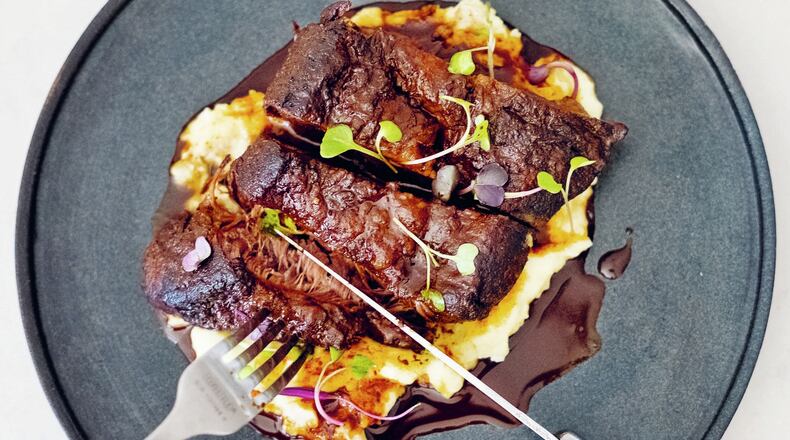In the intro to his debut cookbook, "The Peached Tortilla: Modern Asian Comfort Food From Tokyo to Texas" (Sterling Epicure, $27.95), 36-year-old Eric Silverstein writes: "My love of food is why I'm here today."
Silverstein is the chef-owner of a dynamic Austin, Texas-based hospitality company that includes three restaurants, two food trucks, a full-service catering company and an event space. His culinary journey has been both typical and unusual, and by turns, difficult and fortuitous.
The son of a Jewish American businessman and a Chinese American “tiger mom,” he spent the better part of his childhood in Japan before moving to Atlanta at age 11. As a “mixed-race kid,” who carried a bento box to school at Pace Academy in Buckhead, he notes he never felt that he “fit the mold.”
By age 27, Silverstein was a law school grad with a six-figure income from working as a litigator. But after three years, he left that life behind to start a food truck business in 2010, soon flipped it into a catering company, and in 2014, finally realized his lifelong dream of opening a restaurant.
Silverstein describes his cooking and the recipes in “The Peached Tortilla” cookbook as “a cultural mishmash” — much like his own Chinese, Jewish, American, Japanese and Southern influences.
And in prose that flashes with attitude (and sometimes profanity), he proudly proclaims his love for fast food as comfort food, going back to his dad’s job with Kentucky Fried Chicken in Japan, and his obsession with MOS Burger, “the epitome of Japanese-American fusion.”
I met up with Silverstein while he was in town for the annual Atlanta Food & Wine Festival. One morning over breakfast at Pancake Social at Ponce City Market, we talked about his approach to writing a cookbook that's as much a memoir as a collection of recipes.
“The memoir part of it was really important,” Silverstein said. “I didn’t want to just do a cookbook. I really wanted to tell my story. And part of that was because people ask me about the business, and ask me for my advice and help. The struggle is real in the food truck business, and the restaurant business in general. It’s tough, and it’s fickle.”
Though he wouldn’t understand exactly why until much later, Silverstein said his formative years in Tokyo were the key to his abiding sense of food and cooking.
“Living in Japan was the normal for me. Living in the United States was the weird thing,” he said. “The food culture in Japan is unrivaled, in my opinion. And it was doubled by the fact that we would travel to Singapore a lot. But that didn’t prepare me for moving to Atlanta and going to a private school. I don’t think the other students understood who I was.
“How many kids from Japan come to Pace? None. On top of that, there was a dress code, and we had to shop for khaki pants. I’m eating food that’s completely different. My mom’s packing me bento boxes. I took a lot of ‘crap’ in junior high. It wasn’t fun. Now, to come back and cook the food that I grew up eating, and people appreciate it, and it gets me on TV. I thought I had to limit myself back then, which is why I think I’m really expressing myself so much now.”
Putting down roots in Austin, and starting a business there, proved to be the turning point in Silverstein’s life and career. But he’s candid about how little he knew about what he was getting into.
“It was a steep learning curve,” he said. “Nine years later, I look back and wonder how I did it. But you’ve got to start somewhere, right? I’ve had the opportunity to learn from really smart people, including chefs and restaurateurs. And the timing was right in 2010. Austin has been really good to me as a city. I have real relationships with customers. They identify with the journey, and they identify with the food.”
These recipes and notes from “The Peached Tortilla: Modern Asian Comfort Food From Tokyo to Texas” (Sterling Epicure, $27.95) by Austin, Texas, chef and restaurateur Eric Silverstein call for Asian ingredients you can easily find at Asian markets, and often the international food sections at large supermarkets.
Umami Fried Chicken
“We do a Fried Chicken and Whiskey Night at the restaurant that epitomizes the best of Southern and Asian cooking,” Silverstein says in his cookbook. “Our fried chicken is marinated overnight in a blend of Asian ingredients, and instead of dredging the chicken in buttermilk and flour, we use rice flour for a crisper crunch. While this chicken recipe isn’t meant to be Japanese KFC, I think it makes a damn good case for Thai KFC.”
Here’s what Silverstein has to say about this comfort food recipe: “When our catering operation gradually grew into a full-service operation, our menu evolved with it. We created an entirely new section of the menu that focused on comfort food. Braised short ribs are the epitome of American comfort food. Almost anyone attending a wedding or corporate event can get behind braised short ribs. Of course, we had to put our own spin on the standard recipe by adding some Korean flair.
“Note: I prefer bone-in short ribs, but sometimes they are a little bit more challenging to find and a little bit pricier for the yield (since you are also paying for the weight of the bone). Another option is boneless chuck tail flap. This is boneless short rib, available at most large supermarkets. If you purchase boneless short rib, you will only need 1 3/4 pounds, since you are not factoring in the weight of the bone.”
“These mashed potatoes have been a hit on our catering menu ever since we introduced them,” Silverstein says in “The Peached Tortilla: Modern Asian Comfort Food From Tokyo to Texas.” “Mashed potatoes are certainly approachable, but, in general, I find them a little boring. These, however, are kicked up with wasabi powder, and they are addictive. They make a great pair with braised short ribs or any type of steak or braised meat. You can also top them with some fried shallots or garlic for extra crunch.”
In his cookbook, Silverstein explains the thinking behind this cocktail: “The Japanese have been producing commercial whiskey for over ninety years. In the past five to ten years, the top Japanese whiskies have become renowned everywhere. For the purposes of this cocktail, a Japanese blended whiskey, as opposed to a Scotch whiskey, will work perfectly. The Japanese have really mastered the art and craft of whiskey blending, the main driver behind the current popularity of Japanese whiskey.”
Read more stories like this by liking Atlanta Restaurant Scene on Facebook, following @ATLDiningNews on Twitter and @ajcdining on Instagram.
About the Author
Keep Reading
The Latest
Featured







